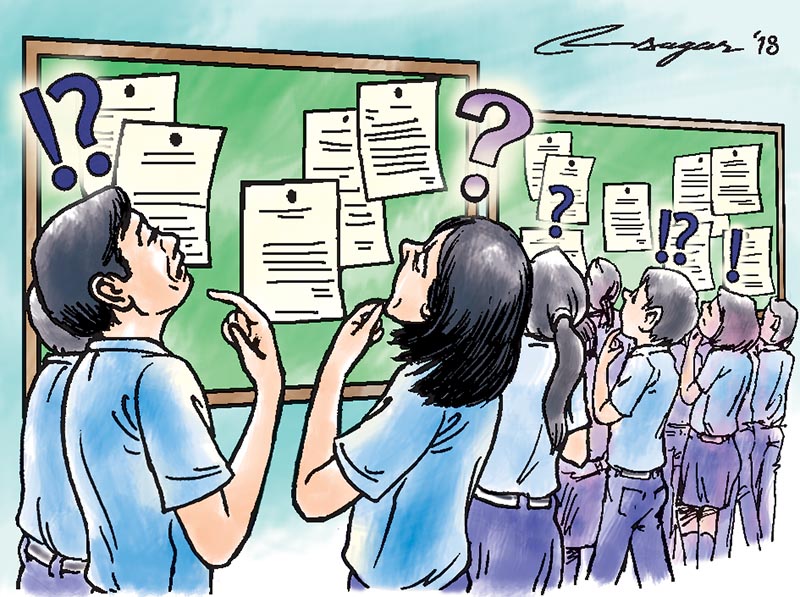When exam board fails: NEB’s role is a letdown
At a time when students were desperately looking for right information regarding eligibility criteria for SEE supplementary examinations, Nepal Examination Board published different notices one after another only to confuse students
The National Examination Board (NEB) issued three different notices in a span of seven days in the last week of June regarding supplementary examinations. It was after Secondary Education Examination (SEE) results were published. Surprisingly, NEB’s confusing information perplexed all those who desperately needed accurate information about the supplementary examinations. This inability of the NEB to clearly communicate information speaks volumes about existing government institutions, their functions and efficiency. This also reveals the poor functioning of government institutions in the country.
Over the years, such incidents have occurred repeatedly.
During result publication also the NEB had made a blunder. Due to the negligence on the part of the NEB in publishing SEE results this year, a student committed suicide “for scoring lower grades”. Later it was revealed that it was a mistake and that she had scored better grades. Who is to be blamed for this? Who should be accountable for this loss of life? Should no one be responsible for such an event?
As citizens are raising their voice against such state of affairs, there should not be any let-up in seeking answers from the concerned authority. And those who are responsible should be brought to justice.
It is glaring that the NEB fails to inform its key decisions clearly on a timely basis. Why should a government institution be so inept to provide information in as clear language as possible? What do common folk infer from this? Should we assume that those in the NEB are inefficient and are not capable of fulfilling their due responsibilities? If this is the case, why should citizens waste their tax on them? What is the use of entrusting them with such an important task?
If the concerned authorities are incompetent, there must be some provisions in place to take them to the task or relieve them of their duties immediately.
At a time when students and teachers were desperately looking for the right information regarding eligibility criteria for supplementary examinations, the NEB needed to work prudently as not to create any confusion. But instead, the NEB published notices one after another, creating more confusion.
For instance, on June 29, the NEB announced that those who secured grade C and below in two subjects (in theory) would be eligible for supplementary examinations. But two days later — on July 1 — the NEB published another notice without mentioning the number of subjects as the eligibility criteria for the supplementary examination. The lack of clarity confused many students and teachers. With just one month to go for the exam, one can easily imagine the pressure the confusing notices put on the students.
NEB officials need to realise that they assume important responsibility and no let-up in this regard could be excused.
The simple but most important point – conveying clear and reliable information to citizens – should not be compromised under any pretext. Citizens assume that NEB authorities do have this competency and capability. The Government of Nepal has conferred this critical task on the NEB for the best interests of citizens.
As citizens have paid tax for them, the NEB authorities should do all they can as envisioned legally.
Publishing confusing notices is tantamount to jeopardising the future of several students.
Information is constitutionally guaranteed right of citizens. But citizens have been facing myriad challenges while seeking information.
My colleagues made visits to the concerned authorities and multiple calls to the NEB, but to no avail. Imagine the situation of the citizens and students concerned and the difficulties they may have faced when it comes to accessing simple information like eligibility criteria for supplementary examinations. The NEB is one example of how our public institutions function, and it paints a grim picture of our governance system.
In fact, the case of the NEB shows the prevalent nature of government institutions and their functioning. In other words, this incident showcases sheer apathy on the part of government employees to undertake their duties and serve citizens in the best way possible. Most of our government institutions have the bad image when it comes to the flow of information. When information itself is few and far between, citizens are still very far from right information.
This is a bitter reality, and it leads to inefficiency in the government services that is currently rampant in Nepal. This sort of attitude among government employees has created difficulties for citizens to realise the fundamental rights guaranteed by our constitution.
The working culture and system of government institutions have been the major reasons for the failure to deliver required services to citizens effectively and timely. In many cases, government employees hardly follow rules and regulations as stipulated by the constitutions as well as legal provisions.
Additionally, they are not monitored and supervised by the concerned authorities or line agencies. This has been the major reason for the lack of efficiency in the government institutions with regard to public sector delivery.
Public institutions and officials there must work in the larger interest of the general public.






